
戦略における「面白い」要素をどのように着想すればよいのか?
前回の記事では、価値創造プロセスの二つ目となる「エスノグラフィー」についてお話ししました。今回は、価値創造プロセスの三つ目となる「戦略ストーリー要素の導出」についてお話しします。
価値創造プロセスの全体像はこちらとなります。

アブダクションプロセスによって、直感を形にする
③戦略ストーリー要素の導出:
戦略ストーリーにつながる新しい要素を、アブダクションプロセスにより導出する
ここまでの「戦略ストーリーの直感」や「エスノグラフィー」は、直感する・感じるという感覚的・非言語的なプロセスでしたが、以降は徐々に具現化・概念化・言語化のプロセスに入っていきます。
アブダクションとは「仮説的推論」と訳される概念です。ここでは「それまで直感したこと、体感したことを具現化する新しい価値をイメージする・言語化する」というニュアンスで捉えて頂ければ大丈夫です。
アブダクションは、シャーロックホームズ、あるいは、名探偵コナンによくでてくる思考プロセスです。事件の現場に落ちていたAという証拠、Bという目撃情報、Cという関係者からの情報、を合わせて考えると、犯人はXに違いない!というようなイメージですね。
ここでポイントとなるのは、AとBとCから必然的にXが導かれるわけではないということです。逆に、X(犯人)がわかっていれば、XからAとBとCは必然的に導くことができるはずです。必然的に導かれるわけではないのに、アブダクションプロセスによって犯人を特定しまうところに、シャーロックホームズや名探偵コナンの凄さと面白さがありますね。
必然的に導かれるわけではないというところが、アブダクションプロセスが論理的思考における演繹法や帰納法とは異なる点になります。「仮説的推論」と呼ばれているのも、必然的な帰結ではないということが含意されています。
「必然的に導くことができないとするならば、どうやって実践すればよいのか?」

そんな疑問が湧きますね。おっしゃる通り、必然的に導くことができないということは、このようにすれば必ず結論がでてくるというような、思考プロセスの全てを定義することはできない、ということになります。
感覚的にお伝えするならば、「これまで直感したこと、体感したことについて、合理的な繋がりを与えるような、まだ見えない本質的なものは何か?」を名探偵になった気分で探し当てよう、という感じになります。いくつかの証拠や証言A、B、Cを合理的に説明するような、犯人Xを特定しようとするのと同じですね。
もう少し、説明的にお話しするならば、次の図で示されるような機序になります。(ただし、先ほど述べたように、詳細を全て定義できるものではありませんので、概観を示しているものとして捉えて頂ければと思います)

この図で、既にわかっていることはS1、S2、S3です。E1、E2、E3は、S1、S2、S3という示唆を得る元となった直接的な経験を指しています。アブダクションプロセスとしては、S1、S2、S3というヒントから、Aというコンセプト・理念・大法則を導きます。先ほどの例で、A、B、Cという証拠・証言から犯人Xを特定するプロセスと全く同じです。
この図では、直感意識で捉えている上側の領域と、身体意識で捉えている下側の領域を行ったり来たりしながら、Aを導いています。これは、価値創造プロセスの「戦略ストーリーの直感」(直感意識がメイン)と「エスノグラフィー」(身体意識がメイン)で感じたことを、行ったり来たりしながら探っていく様子を表しています。
探偵小説においても、一筋縄ではいかない事件を、粘り強く行ったり来たりしながら、試行錯誤しながら解決に近づいていくストーリーが描かれますが、それと同じイメージですね。

メタファーやアナロジーを活用して、直感したイメージを言語化する
アブダクションプロセスによって得た感覚を言語化していくときに、重要になってくるのが「メタファー」と「アナロジー」です。どちらも「ある事象を他の事象になぞらえて考える・表現する」といった意味を持ちますが、ここでは異なる概念として考えます。
「メタファー」は、言語化しづらい概念を純度高く共有するにあたって非常に有効な手段です。言語で説明的に表現するよりも、細かいニュアンスも含めてかえって共有しやすい場合もあります。
例えば、「理論は建物である」というメタファーを考えましょう。
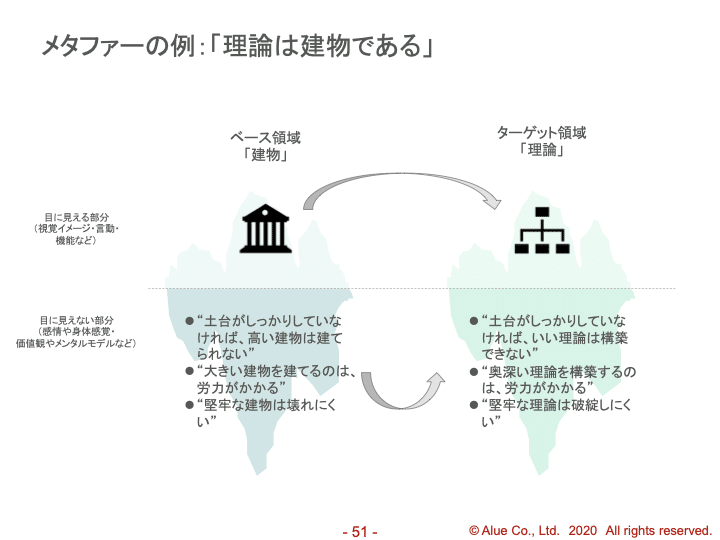
このメタファーは非常に強力です。「建物」という言葉だけで、
・土台がしっかりしている必要がある
・大きいものをつくるには時間がかかる
・堅牢につくられたのであれば壊れにくい
といった意味が、説明しなくても感覚的に伝わります。メタファーは、目に見えないメンタルモデル、付随する身体感覚、感情をセットにして伝えることができます。
さらに、メタファーの題材として何をとりあげるかによって、質感の違いを表現することもできます。例えば「地球は生命体である」というメタファーは、地球は人間の体のようにデリケートで、意思を持っているかのような、有機的なイメージを伝えられます。
これに対して「地球は容器である」というメタファーを使った場合、地球は人によるコントロールが可能で無機質なイメージになるでしょう。この2つのメタファーでは、伝わるものの質感が相当異なることを実感いただけるのではないでしょうか。
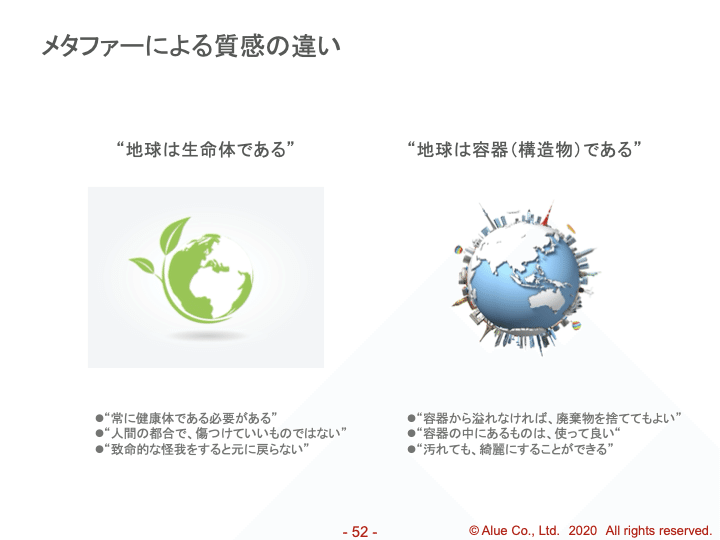
一方、「アナロジー」は、概念を要素分解し、他の概念との共通要素を探っていく思考法です。メタファーと比較するともう少し分析的です。
例えば、採用活動をマーケティング手法になぞらえて検討してみます。「ターゲット選定」「ニーズの特定」といったマーケティングプロセスを分解すると、そのまま採用活動にも適用できることがわかります。これが「アナロジー」の活用例です。

メタファーもアナロジーのいずれも、直感的・感覚的なものを具現化・言語化していく際に非常に有効です。
「なぜ、直感的・感覚的なものを、直接的に説明するのではなく、メタファーやアナロジーを用いる必要があるのか?」
という疑問を持たれる方もいらっしゃるのではないでしょうか。おっしゃる通り、直接的に説明することができれば、それでも良いと思います。そのときに、わざわざメタファーやアナロジーを用いる必要はないでしょう。
メタファーやアナロジーを用いるメリットとしては、次のようなことが挙げられます。
▼言語化しにくいニュアンスを、共有しやすい形で言語化することができる
メタファーは目に見える事象だけではなく、それに付随するメンタルモデル・身体感覚・感情を表現することができますので、言語化しにくいニュアンスを丸ごと表現することに役立ちます。
▼これまでは気づかなかった新しい要素を見出すことができる
アナロジーによる比較によって、これまでに気づかなかった新しい要素を見出すことができる場合があります。
このようなメリットがありますので、直感的・感覚的な内容を直接的に言語化することが難しいと感じたときはもちろんのこと、比較的言語化ができている場合であっても、積極的にメタファーやアナロジーを活用することをお勧めします。
100本ノックというメタファー
アブダクションプロセスとメタファーの事例としては、当社の創業期のメイン商品となる100本ノックについてのエピソードをご紹介したいと思います。
以前の記事で100本ノックというコンセプトが生まれてきた経緯をお話ししましたが、このプロセスがまさにアブダクションプロセスになっています。
直感していること
・先生の話を一方的に聞いているだけの講義が、本当に効果的なのだろうか?そうではない方法もあるのではないだろうか?
→「どのような研修であれば、受講生がより楽しく取り組むことができ、実際の仕事における成果に結びつくか」という問いをもつ
実感・体感していること
・コンサルティング会社に勤務している時期に、アウトプットした内容に対して先輩コンサルタントからたくさんのフィードバックをもらったことが、自分の成長につながった。アウトプットをすることが学びにつながる
・大学時代に打ち込んだテニスの経験から考えて、とても緊張する試合において、自信をもってプレーするためには、練習において100回繰り返し再現できるようなショットを身につけておく必要がある。このためには、徹底的な反復練習が必要。
このような直感・感覚を持ちながら「どのような研修であれば、受講生がより楽しく取り組むことができ、実際の仕事における成果に結びつくか」という問いを持ち続けて、創業メンバーで話をする中で、「100本ノック」というコンセプトが生まれてきたことは、上記のnoteでお話ししました。
このプロセスが、直感意識や身体意識で捉えていることを元にしながら、それらに共通する本質的な何かを探っていくアブダクションプロセスになっていることはお分かりいただけるかと思います。
そして、見出した「何か」を、「100本ノック」という野球のメタファーで表現しています。これを「アウトプットによる反復練習中心の研修スタイル」という表現することも可能ですが、それだけでは伝わらないものがあります。
「100本ノック」というメタファーを用いることで、「アウトプットによる反復練習中心の研修スタイル」という説明では表現できない、次のようなニュアンスを含めることができています。
▼(試合などの)成果を生み出す場を想定していること(成果を生み出すためのトレーニングであること)
▼やれば誰でもできるということ(できるかできないか、ではなく、やるかやらないか、であること)
▼「わかる(ノックの取り方を理解している)」と「できる(ノックを2−3本とることができる」と「習慣化(100本を当たり前にとれる)」の違いがあること

そして、「100本ノック」をアナロジーとして構成要素比較することによって、次のような新しい発想を得ることもできました。
▼(野球においては)試合などでの結果をもとに、課題意識をもって練習に臨むことが大切である
→(研修においても)仕事のプロセスや成果をもとに、課題意識をもって研修に臨むことが大切である
▼(野球においては)ただ闇雲にノックを受けるだけではなく、コーチからのフィードバックやアドバイスがあった方がよい
→(研修においても)ただ闇雲にアウトプットするだけではなく、それに対してフィードバックやアドバイスがあった方がよい
▼(野球においては)適切な負荷と、適切な反復回数が存在する
→(研修においても)演習の難易度と反復する回数の設計が大切である
これらの発想は、全て「100本ノック研修」の中に、必須の要素として盛り込まれています。
今回は、価値創造プロセスの三つ目となる「戦略ストーリー要素の導出」についてお話ししました。次回は、四つ目のプロセスとなる「連結化・ストーリー化」についてお話しします。
本日の問いとなります。(よろしければ、コメントにご意見ください)
・あなたの経験において、探偵のようにアブダクションプロセスによって、着想を得たことがあるとすれば、それはどのような経験でしたか?
・あなたの経験において、メタファーやアナロジーを用いることによって、考えていること・思っていることを伝えやすかったことがあるとすれば、それはどのような経験でしたか?
How do we come up with the "interesting" elements of our strategy?
In my previous article, I talked about the second process of value creation, "ethnography." In this article, I would like to talk about the third process of value creation, "Derivation of strategy story elements."
The whole value creation process is shown here.
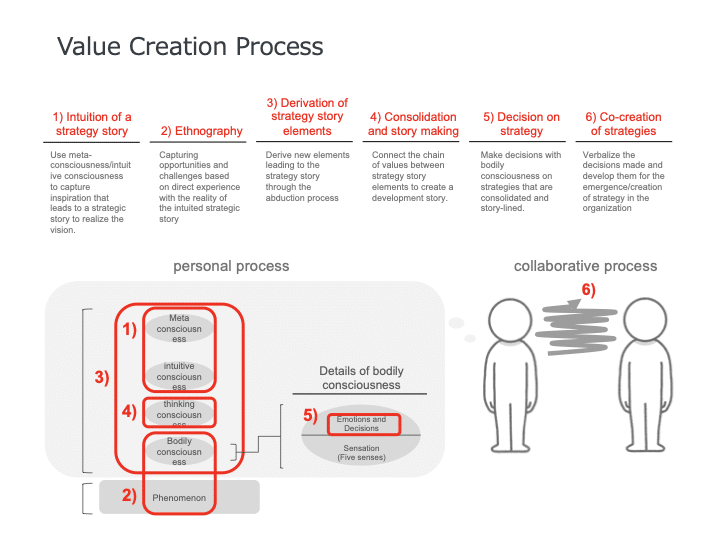
Give shape to intuitions through abduction processes
3) Derivation of strategy story elements
Derive new elements leading to the strategy story through the abduction process
Up to this point, "intuition of a strategy story" and "ethnography" were sensory and non-verbal processes of intuiting and feeling, but from here on, we will gradually enter the process of embodiment, conceptualization, and verbalization.
Abduction(Retroduction) is a concept that can be translated as "hypothetical reasoning. In this context, it can be understood as "imagining and verbalizing a new value that embodies what has been intuited and experienced.
Abduction is a thought process that is often seen in Sherlock Holmes or Detective Conan. If we combine the evidence (A) found at the crime scene, the eyewitness (B), and the information (C) from the people involved, the culprit must be X! That's the image.
The point here is that X is not inevitably derived from A, B and C. On the contrary, if X (the culprit) is known, then A, B, and C should be inevitably derived from X. The greatness and fun of Sherlock Holmes and Detective Conan lies in the fact that they identify the culprit through the abduction process, even though it is not inevitable.
The abduction process differs from deduction and induction in logical thinking in that it is not an inevitable consequence. The fact that it is called "hypothetical reasoning" implies that it is not an inevitable consequence.
"If we can't lead by necessity, how can we implement it?"
That's the question that comes to mind. As you say, the fact that we cannot lead inevitably means that we cannot define the entire thinking process, such as the one that always leads to a conclusion in a certain way.
If I were to describe it in terms of feeling, I would say that it's like being a great detective and trying to figure out, "What is the essential thing that we haven't seen yet that would give us a rational connection to what we have intuited and experienced so far?" It's like trying to identify culprit X, which would rationally explain several pieces of evidence and testimonies A, B, and C.
If I were to explain it in more descriptive terms, the mechanism would be as shown in the following figure. (However, as I mentioned earlier, not all the details can be defined, so please take this as an overview.)
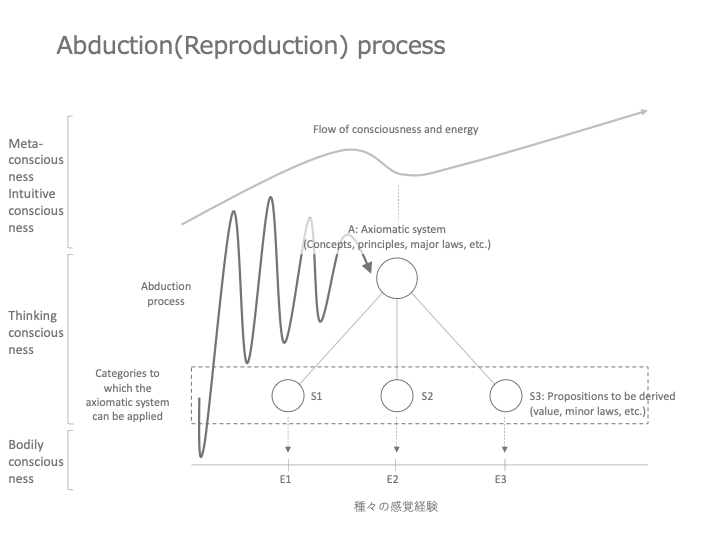
In this diagram, what we already know are S1, S2, and S3; E1, E2, and E3 refer to the direct experience that led to the implications of S1, S2, and S3. In the abduction process, the implications of S1, S2, and S3 are used to derive the concept, idea, and general law of A. This is exactly the same as the process of identifying the culprit X from the evidence and testimony of A, B, and C in the previous example.
In this diagram, A is led back and forth between the upper region, which is perceived by the intuition consciousness, and the lower region, which is perceived by the bodily consciousness. This shows the back-and-forth exploration of what is felt in the "strategic story intuition" (mainly intuition consciousness) and "ethnography" (mainly body consciousness) of the value creation process.
In detective novels, there are stories of cases that are not easy to solve, but through persistence, back and forth, and trial and error, they come closer to a solution, which is the same image as this.
Use metaphors and analogies to verbalize the images that have been intuited
"Metaphors" and "analogies" are important when verbalizing the sensations obtained through the abduction process. Both have the meaning of "thinking and expressing a certain thing by comparing it to another thing," but we will consider them as different concepts here.
Metaphors are a very effective way to share concepts that are difficult to verbalize in a highly pure way. In some cases, they are easier to share than verbal descriptions, because they include detailed nuances.
For example, let's consider the metaphor that "theory is a building."

This metaphor is very powerful. Just the word "building" is enough to say...
・The foundation needs to be solid.
・It takes time to build something big.
・If it is made robustly, it is hard to break.
Metaphors can convey the meaning of something without explanation. Metaphors can convey a set of invisible mental models, accompanying physical sensations, and emotions.
Furthermore, depending on what we choose as the subject of the metaphor, we can express different textures. For example, the metaphor "the earth is a living organism" can convey an organic image, as if the earth is as delicate as a human body and has a will of its own.
On the other hand, if we use the metaphor "the earth is a container," the image of the earth will be inorganic and controllable by people. I think you will find that the texture of what is conveyed by these two metaphors is quite different.
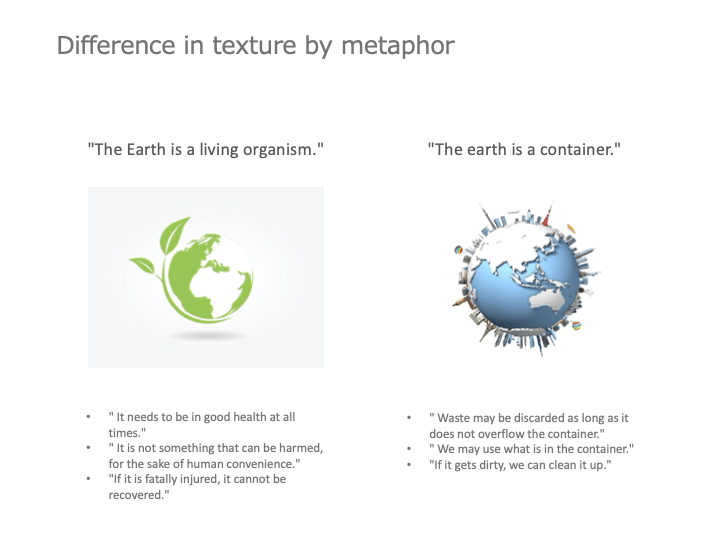
Analogy, on the other hand, is a way of thinking that breaks down a concept into its elements and looks for common elements with other concepts. It is a bit more analytical than metaphor.
For example, let's compare recruiting activities to a marketing method. If we break down marketing processes such as "target selection" and "needs identification," we can see that they can be directly applied to recruitment activities. This is an example of the use of analogy.
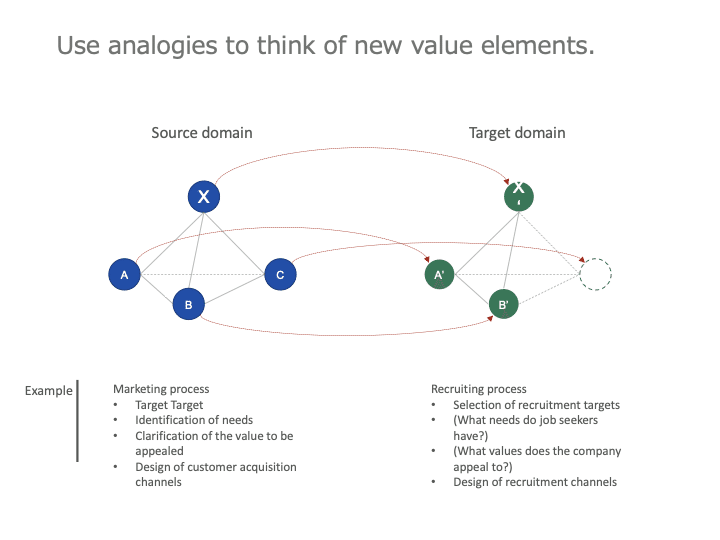
Both metaphors and analogies are very useful in embodying and verbalizing what is intuitive and sensory.
"Why do we need to use metaphors and analogies to explain intuitive and sensory things, rather than explaining them directly?"
I think some people may have this question. As you say, if you can explain it directly, that's fine. There is no need to use metaphors or analogies in that case.
The advantages of using metaphors and analogies include the following.
The ability to verbalize difficult-to-verbalize nuances in a way that is easy to share.
Metaphors can express not only visible events, but also the mental models, physical sensations, and emotions associated with them.
It can reveal new elements that were previously unnoticed.
Comparison by analogy can reveal new elements that were previously unnoticed.
Because of these advantages, I recommend that you actively use metaphors and analogies whenever you find it difficult to directly verbalize intuitive or sensory content, and even when you are relatively able to do so.
The Metaphor of 100 Fungos
As an example of the abduction process and metaphors, I would like to share an episode about 100 fungos, our main product in the early days of our company.
In my previous article, I talked about how the concept of 100 fungos was born, and this process is exactly the abduction process.
My intuition
Is it really effective to just listen to the teacher talk one way? Isn't there another way?
→Have a quest(question): "What kind of training would make the participants enjoy the training more and lead to actual outcomes in their work?
My feeling and experience
When I was working for a consulting company, I received a lot of feedback from senior consultants on my output, which led to my personal growth. Outputting leads to learning.
In order to play tennis with confidence in a very tense match, I needed to acquire shots that I could reproduce 100 times in practice. For this, thorough repetition practice is necessary.
I mentioned in the above note that the concept of "100 Fungos" was born through discussions among the founding members of the company, who kept asking the question, "What kind of training would make it more enjoyable for the participants and lead to actual outcomes in their work?"
You can see that this process is an abduction process, which is based on what we perceive in our intuitive and bodily consciousness, but also explores something essential that is common to all of them.
The "something" that was discovered is expressed in the baseball metaphor of "100 Fungos". This could be described as "a training style that focuses on repetitive practice through output," but there is something that cannot be conveyed by that alone.
By using the metaphor of "100 Fungos," we are able to include the following nuances that cannot be expressed in the description of "a training style that focuses on repetitive practice through output."
▼Assuming a place to produce outcomes.
The training must be designed to produce outcomes.)
▼That anyone can do it if they try.
It's not a matter of whether you can or can't, but whether you will or won't.
▼Gap between knowing/ Doing/ Getting used to
There is a difference between what we understand, what we can do, and what we are used to doing.
And by comparing the components of "100 Fungos" in actual baseball as an analogy, we were able to come up with the following new ideas.
▼In baseball, it is important to practice with intention based on the results of the game.
→In training, it is important to attend training with intention based on work processes and results.
▼In baseball, it is better to have feedback and advice from the coach than to just receive balls without thinking.
→In training, it is better to get feedback and advice on our output than to just output it without thinking.
▼In baseball, there is an appropriate load and an appropriate number of repetitions.
→In training, it is important to design the difficulty level of the exercise and the number of repetitions.
All of these ideas are included in the "100 Fungos Training" as essential elements.
In this article, I talked about the third process of value creation, "deriving strategy story elements." In the next article, we will discuss the fourth process, "consolidation and story making."
Here are the quests of the day. (If you'd like, please share your thoughts in the comments.)
・In your experience, if you have ever been inspired by the abduction process, like a detective, what was that experience like?
・What experiences, if any, have you had where you found it easier to communicate your thoughts and feelings through the use of metaphors and analogies?
Bunshiro Ochiai
この記事が気に入ったらサポートをしてみませんか?
